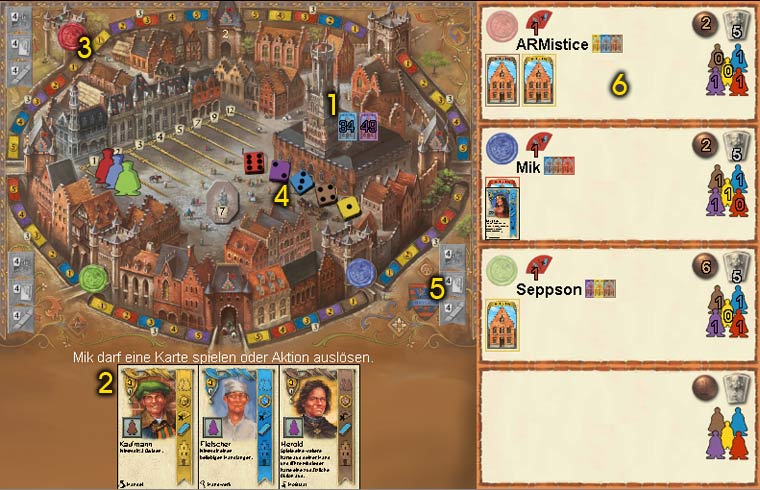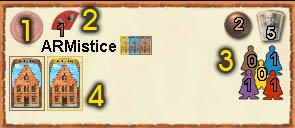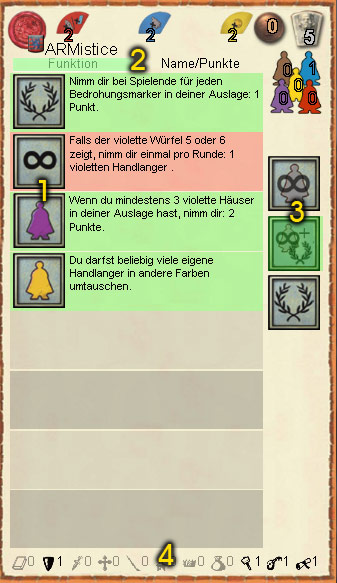Brügge
Het spel
2 - 4 players take on the roles of merchants in Bruges who maintain their relationships with the city's powerful. They compete for influence, power and status.
Using their hand cards, players try to build houses and canals. In particular, you can gain special skills and points by using the cards in your hand as people.
This rule mainly provides the controls for online play. For any other rule questions that arise, the original instructions can be used, which can be downloaded from the publisher's website as complete rules. YouTube also offers some video reviews to get you started quickly.
Het Speelbord < /h3> 
- Draw card stack
- Own cards
- Blue player's starting gate
- current dice
- Red player's majority marker
- Player display
Above your own hand cards you can see which action must be carried out by which player at the moment.

The players' player displays are visible on the right. There you can see your own guilders, the victory points you have already earned and the number of henchmen in the right area (3). You can use the seal (1) to see which player's turn it is and by clicking on it you can switch to the detailed map view of the respective player. In the left area above the name (2) you can see the threat markers of the respective player. Below (4) is the player's "display" with his houses and the people living there.
Spelvoorbereiding< /span>
There are 165 playing cards in 5 different colors in the game, which are also visible to everyone on the back. At the beginning, two face-down piles are formed from which the players draw their hand cards.
Each player receives 5 guilders and 5 victory points as starting capital, and he also receives a henchman for each color ( 5 different colors).
Spelverloop
Bruges runs over several Rounds in which each player takes 4 turns and makes one move each. At the beginning of a round the 5 dice are re-rolled. For each roll of a five or six, players receive a threat token of the corresponding color. If players then have 3 markers of one color, damage occurs which can result in the loss of money, victory points, buildings, people or henchmen. Each player can then move up one step on the promotion track. The cost for this is the sum of all dice with a numerical value of 1 or 2.
In each turn, each player MUST use one of their hand cards , and CAN use actions of the people already on display before or after. The game ends at the end of the round when one of the two decks of cards becomes empty. This is then filled up so that you can continue drawing from 2 stacks.
After the end of the four moves, the majorities are in checked in the areas of advancement, channel and people. If a player has the sole majority, he receives the corresponding marker, which he keeps until the end of the game. Regardless of whether he loses the majority again.
Kaarten spelen
 < p> Generally you have 6 different ways to play a card. On your turn, you choose the card to play. You then choose the method of use by either clicking on the corresponding symbol in the right column (1) or by clicking on the costs (2) to play the person into a free house, if this is possible.
< p> Generally you have 6 different ways to play a card. On your turn, you choose the card to play. You then choose the method of use by either clicking on the corresponding symbol in the right column (1) or by clicking on the costs (2) to play the person into a free house, if this is possible. In addition to their color and the costs for the lead already mentioned, a person also has a victory point value of 0-4 at the end of the game, shown under the costs, and belongs to one of 11 groups of people. This is shown at the bottom of the map.
From top to bottom, the following actions are possible on the right: < /p>
- Take henchmen (2 henchmen in the color of the card)
- Earn guilders (corresponding to the dice value of the same colored die)
- Threat remove (remove 1 threat of the card color + get 1 victory point)
- Build a channel (build 1 channel on a channel space of the card color. Only possible if one of the two currently possible channel spaces has the appropriate color and you have the one on the can pay the costs shown in the channel field.)
- Build a house (Build a house in the card color. Cost: 1 henchman of the card color)
Finally, at the top left is the following Action possible:
- Lay out a person (Requires a free building of any color. Furthermore, the costs shown must be paid.)
Player details

In the detailed view of a player you can see the functions of the played character cards . Here it is possible to use the card's ability by clicking on the "trigger symbol" (1). If the background is green, the card can be used. If the background is reddish, the card cannot be used at the moment.
There are the following card types:
The infinity symbol means, that the function of the card can be triggered without additional costs. The symbol is also clicked for this. If they do not affect a specific game situation (e.g. whenever you build a house), you can only use them once per round.
The henchman symbol means that you have to use a henchman to trigger the function must be given in this color. To do this, click on the henchman symbol.
A laurel wreath means that you get points at the end of the game.
The lightning bolt symbol means that the function is triggered exactly once when the card is laid out.
By switching between function and name/points (2) you can choose between the description of the functionality and the name and the victory points at the end of the game of the card. Using the selectors (3), you can limit the display to action cards from top to bottom, show all cards or only show the victory point cards at the end of the game.
< p> Below (4) the numbers of people played in the eleven groups of people are shown. This is relevant for many cards.Speleinde
Was the When the last round is completed, the game ends. At the end of the game, all points achieved are added up:
- Points through the advancement track (1-12 points, depending on the level reached)
- Points for building canals/statues (3 points per side for 3 canals and up to 7 points per statue for a completely built side)
- Points for the buildings (1 point per house)
- Points for the people (0-4 points, depending on the value)
- Points through victory point cards (according to the card text of the people with laurel wreaths)
- Points for the majority markers (4 each Points for promotion, channel and majority of people)
The player with the most victory points wins. In case of a tie, the number of guilders decides. If there is a tie here too, there are multiple winners.

